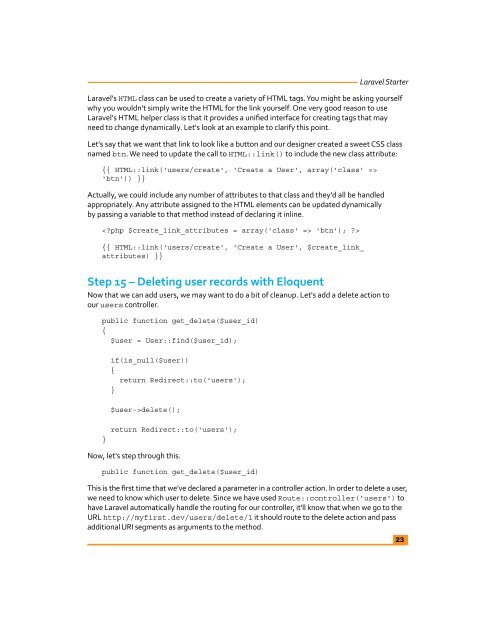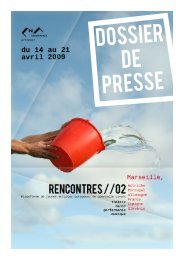Laravel Starter - PHP User Group (Myanmar)
Laravel Starter - PHP User Group (Myanmar)
Laravel Starter - PHP User Group (Myanmar)
Create successful ePaper yourself
Turn your PDF publications into a flip-book with our unique Google optimized e-Paper software.
<strong>Laravel</strong> <strong>Starter</strong><br />
<strong>Laravel</strong>'s HTML class can be used to create a variety of HTML tags. You might be asking yourself<br />
why you wouldn't simply write the HTML for the link yourself. One very good reason to use<br />
<strong>Laravel</strong>'s HTML helper class is that it provides a unified interface for creating tags that may<br />
need to change dynamically. Let's look at an example to clarify this point.<br />
Let's say that we want that link to look like a button and our designer created a sweet CSS class<br />
named btn. We need to update the call to HTML::link() to include the new class attribute:<br />
{{ HTML::link('users/create', 'Create a <strong>User</strong>', array('class' =><br />
'btn')) }}<br />
Actually, we could include any number of attributes to that class and they'd all be handled<br />
appropriately. Any attribute assigned to the HTML elements can be updated dynamically<br />
by passing a variable to that method instead of declaring it inline.<br />
<br />
{{ HTML::link('users/create', 'Create a <strong>User</strong>', $create_link_<br />
attributes) }}<br />
Step 15 – Deleting user records with Eloquent<br />
Now that we can add users, we may want to do a bit of cleanup. Let's add a delete action to<br />
our users controller.<br />
public function get_delete($user_id)<br />
{<br />
$user = <strong>User</strong>::find($user_id);<br />
if(is_null($user))<br />
{<br />
return Redirect::to('users');<br />
}<br />
$user->delete();<br />
}<br />
return Redirect::to('users');<br />
Now, let's step through this.<br />
public function get_delete($user_id)<br />
This is the first time that we've declared a parameter in a controller action. In order to delete a user,<br />
we need to know which user to delete. Since we have used Route::controller('users') to<br />
have <strong>Laravel</strong> automatically handle the routing for our controller, it'll know that when we go to the<br />
URL http://myfirst.dev/users/delete/1 it should route to the delete action and pass<br />
additional URI segments as arguments to the method.<br />
23




